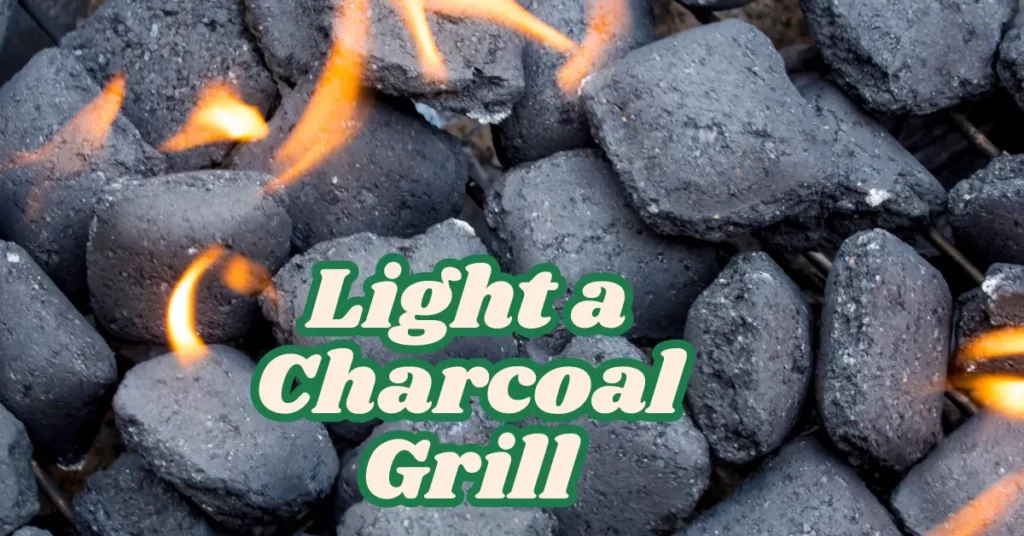This post may contain affiliate links. If you use these links to buy something we may earn a small commission. Thanks.
Charcoal grilling is one of the purest forms of cooking outdoors. That sizzling sound, smoky aroma, and deep flavor nothing quite matches it. One of the most common tools used by grillers is a charcoal chimney starter. It helps ignite coals evenly and quickly without the need for chemicals. But what if you’re ready to grill and realize you don’t have a chimney on hand? Don’t worry there are several tried-and-true ways to light a charcoal grill without one.
In this guide, we’ll walk you through various methods to get your charcoal grill fired up without using a chimney starter. Whether you’re at home, camping, or simply improvising, these techniques will ensure your coals are hot and ready for cooking safely and effectively.
Safety First: Precautions Before Lighting the Grill
Before you strike that first match, let’s talk safety. Lighting charcoal, especially without a chimney, means working with open flames. That calls for careful preparation.
1. Choose the Right Location
Set up your grill in a well-ventilated area, preferably outdoors and away from flammable materials like dry leaves, wooden fences, or patio furniture.
2. Have the Right Gear
You don’t need fancy tools, but a few essentials go a long way:
- Long-handled lighter or fireplace matches
- Heat-resistant gloves
- Long tongs or poker
- Fire extinguisher, water bucket, or hose (just in case)
3. Avoid Hazardous Accelerants
Never use gasoline, kerosene, or other dangerous substances to light charcoal. These are not only flammable but also emit toxic fumes that can ruin your food and risk your safety.

Method 1: Using Lighter Fluid
This is probably the most common alternative to chimney starters. It’s quick, simple, and accessible but it does require some caution.
Step-by-Step Instructions:
- Arrange the Charcoal: Stack your briquettes into a pyramid shape. This promotes airflow and helps the fire spread evenly.
- Apply Lighter Fluid: Pour a moderate amount (about 1/4 cup for 2 pounds of charcoal) over the pile. Do not soak them.
- Wait Before Lighting: Let the fluid absorb for about 30 seconds. This prevents sudden flare-ups.
- Ignite Carefully: Use a long lighter or match to light the charcoal in several spots around the base.
- Let It Burn: Wait until the coals are white-gray and ashed over, typically around 20-30 minutes.
Pros:
- Fast and straightforward
- Charcoal lights evenly when done right
Cons:
- Can leave a chemical taste if not burned off properly
- Not the most eco-friendly or flavorful method
Method 2: Newspaper and Vegetable Oil
If you prefer a more natural approach, using newspaper and vegetable oil is an old-school method that still works like a charm.
How to Do It:
- Prepare the Newspaper: Crumple 4 to 5 sheets of newspaper and drizzle a bit of vegetable oil over them. This helps them burn longer and hotter.
- Position the Newspaper: Place the paper in the center of your grill’s bottom grate.
- Pile the Charcoal: Stack the charcoal in a pyramid or teepee formation over and around the paper.
- Light It Up: Ignite the newspaper from multiple points using a long lighter.
- Watch It Burn: As the newspaper burns, it will ignite the bottom charcoal, which will then gradually catch the rest.
Tips:
- Make sure the newspaper is dry.
- Avoid smothering the paper with too much charcoal.
- Ensure good airflow by keeping bottom vents open.
Benefits:
- No chemical flavor
- Inexpensive and easily accessible materials
Method 3: Fire Starter Cubes or Natural Starters
Fire starter cubes are one of the most efficient tools for lighting charcoal without a chimney. These small but mighty cubes are clean-burning and odorless.
How to Use Them:
- Place Starters on Grill Grate or Coal Bed: Set 1–2 cubes in the center.
- Arrange the Charcoal: Stack your charcoal around and slightly above the cubes in a pyramid or teepee style.
- Light the Cubes: Use a long lighter to ignite.
- Wait for Flames: Let the coals gradually catch fire, usually within 15–20 minutes.
Advantages:
- Consistent burn time
- No chemicals or odor
- Safe and simple for beginners
Natural Starter Options:
- Wax-infused wood shavings
- Tumbleweed starters
- Sawdust and paraffin blocks
These are especially great for those who prefer chemical-free cooking.
Method 4: Electric Charcoal Starter
If you’re near a power source, an electric starter can be a reliable alternative. It’s a metal loop that heats up and ignites charcoal upon contact.
Instructions:
- Arrange Charcoal: Stack coals in a pile.
- Insert the Starter: Push the heating element into the center of the pile.
- Plug It In: Turn it on and let it sit for 8–10 minutes.
- Remove Carefully: Once you see glowing embers, unplug and remove the device (use gloves—it’s hot!).
- Wait Until Ready: Let the rest of the coals catch and ash over before cooking.
Pros:
- No flames or lighter fluid needed
- Even heat distribution
- Great for home grilling
Considerations:
- Requires electricity nearby
- Not portable for camping or picnics
Method 5: Egg Carton Method
Looking for a DIY-style solution? The egg carton trick is perfect for backyard grilling or even while camping.
Here’s What to Do:
- Get a Cardboard Egg Carton: Avoid styrofoam or plastic only use cardboard.
- Fill It With Charcoal: Place a single briquette in each compartment.
- Place It in the Grill: Set the entire carton on your grill’s lower grate.
- Light the Carton: Use a lighter to ignite one or two corners.
- Let It Burn: The carton will burn completely, lighting the coals in the process.
Benefits:
- Cheap and effective
- Great for outdoor use or impromptu grilling
- Fun DIY method
Tips for Keeping the Fire Going
Once your charcoal is lit, the key is to keep it burning strong and steady. Here’s how:
- Don’t Smother the Coals: Avoid covering them too early with the cooking grate or food.
- Maintain Good Airflow: Use your grill’s bottom and top vents to control oxygen flow. More oxygen = hotter fire.
- Add Charcoal Gradually: Once the initial batch is lit, you can add more charcoal as needed to extend cooking time.
- Resist the Urge to Stir: Let the coals catch and ash over before disturbing them.
Common Mistakes to Avoid
Lighting charcoal without a chimney is simple but it’s easy to mess up without proper technique. Avoid these common pitfalls:
- Using Damp Charcoal: Wet coals won’t ignite properly.
- Overloading the Grill: Too much charcoal can suffocate the flame.
- Poor Ventilation: Closed vents = dying fire.
- Using Unsafe Materials: Never use plastic, painted wood, or dangerous accelerants.
Conclusion
Not having a chimney starter doesn’t mean your grilling plans are toast. Whether you’re using lighter fluid, newspaper and oil, natural fire starters, or even an egg carton, there are plenty of safe and effective ways to light your charcoal grill. Each method has its own benefits depending on your needs speed, flavor, convenience, or environmental friendliness.
Just remember to prioritize safety, ensure proper airflow, and give your coals time to fully ignite before throwing food on the grill. With the right technique and a little patience, you’ll be serving up juicy burgers, smoky ribs, or fire-kissed veggies in no time.
So go ahead light it up, chimney or not. Your grill (and your taste buds) won’t know the difference.
